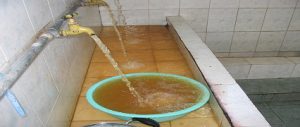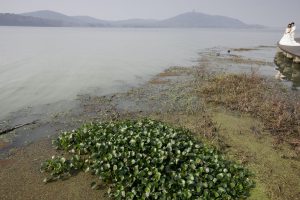The Dongjiang, or Dong River, the eastern tributary of the Pearl River in southern China, supports the lives, livelihoods and environment of almost 40 million people in the southern Chinese cities of Heyuan, Huizhou, Dongguan, Shenzhen, Guangzhou and Hong Kong. It is crucial for the society and economy of Hong Kong and of Guangdong province.
The Hong Kong-based think-tank Civic Exchange carried out a two-week investigation in the Dongjiang basin between October and November last year. This uncovered risks of huge future shortages; cities and industries competing for water; new strains placed on water resources by relocated industries; and a lack of basic protections for village rivers.
First, all of the available water on the Dongjiang is already being used, meaning there is no room for future growth in demand. The Dongjiang basin was the first in China to have a water allocation plan: in 2008, overall limits on the amount of water to be used were set. But by 2010, the five cities in the basin (not including Hong Kong) were either using or close to using all of their allocations. This was particularly the case in Shenzhen, Dongguan, Heyuan and Huizhou, which rely heavily on the river.
Estimates for water use in 2020 predict huge shortages in Shenzhen, Huizhou and Dongguan. Although there are no specific estimates for Heyuan and Guangzhou, development and plans for the future are bound to result in increased demand. By that point, Hong Kong’s needs will also have reached the limit of its allocation from the Dongjiang. (See Table 1)
It can be expected that the existing allocation of water, already stretched, will be unable to support continued demand growth. Flexibility in Hong Kong’s water supply will decrease, and the allocation of water from the Dongjiang will change.
Second, overlapping demand is worsening water quality and exacerbating shortages. In China, population, urbanisation and industrialisation are set to peak simultaneously, creating huge environmental pressures via stacking effect – and the Dongjiang basin is no exception.
Of the five cities in the basin, Guangzhou, Shenzhen and Dongguan are already fully urbanised, and are both highly reliant on and limited by water resources. Huizhou and Heyuan are also very reliant on allocations of water from the river, and these are the destination for industries being relocating from the Pearl River Delta region. With urbanisation and industrialisation happening in tandem, water pressures are greatly exacerbated. Agriculture, industry and cities overlap, creating multiple simultaneous environmental pressures far beyond the environment’s ability to cope. By 2020 in Guangzhou, even if all waste water is treated up to standard before being released, the total pollutants released will still be beyond the amount the river can cope with.
Third, industrial relocations are creating multiple threats for water resources. Industries within the Pearl River Delta area of Guangdong province are relocating to the east, west and the mountainous north of the province – areas which are economically under-developed, ecologically weak and the sources of tributaries to the Pearl River. The primary reasons for the relocation were to decrease social and environmental pressure on the delta, and to balance the economic development of the entire province.
These incoming industries have caused rocketing demand for water, burdened local water resources and overwhelmed the water quality. The poor enforcement and supervision of water-related laws, along with inadequate waste water treatment facilities and standards further stressed loading capacity of the Dongjiang basin. Waste water emissions are increasing and there is intensive hydropower development, which means the rivers cannot cleanse themselves and their ability to absorb pollution is decreasing. Meanwhile, some resource-intensive industries, describing themselves as working in “new energy, new materials” have arrived, bringing about more mining, the destruction of vegetation and damage to water sources.
Fourth, the source of the Dongjiang has been ignored. The source is in Jiangxi province, in south-eastern China, and administratively belongs to that province. The Dongjiang Basin Management Bureau, based in Guangdong province, is responsible for the Dongjiang basin – yet it does not have the right to operate across the provincial border. This created a situation while responsibilities for the source of the Dongjiang are shared, the benefits are not. Xunwu county, where the Dongjiang rises, has made efforts to protect the river, but it is an extremely poor area. If long-lasting policy, financial and technical mechanisms are not in place, there is little that can be done.
Fifth, the investigation found a lack of basic protections for village rivers. Along the entire length of the river, village rubbish and waste water are discharged at will, rather than collected and treated. This both reflects a lack of awareness among villagers, and a failure of government management. Non-managed agricultural sources of pollution also worsen river pollution.
In conclusion, the Dongjiang has been overloaded. If the current mode of development were to proceed as is, the Dongjiang basin could not develop sustainably. All the cities that benefit from the Dongjiang water allocation today would be greatly restricted in future. While the “One country, two systems” principle guides relations between Hong Kong and the mainland, Hong Kong should not ignore the “strictest” new policy from the State Council on water resources management. The Hong Kong government should be open to explore whether it can set a cap on water usage and progressively reduce it. Hong Kong needs a long-term water strategy for the future.
Liu Su is Greater China manager at Civic Exchange. To read more, see Liquid Assets II – Industrial Relocation in Guangdong Province: Avoid Repeating Mistakes, Liquid Assets IIIA:Dongjiang Overloaded – 2011 Dongjiang Expedition Report and Liquid Assets IIIB: A photographic report of the 2011 Dongjiang Expediion.
The homepage photo is by Greenpeace from 2010. It shows a factory in Shenzhen discharging waste water into the Dongbao River, a tributary of the Dongjiang.



